
Event Rig Series – Part 3: A Small Portable Basic Lighting Rig
In the third part of my accidental series on Rig for events, I will look at a basic lighting setup to go with our Audio setup for last time. (Unless you’re really into broadcasting your gigs from the get-go I don’t think you need to worry about the camera setup at this point).
The goal of the Rig
The main focus of this rig is to be seen in a dark dingy local pub that hasn’t had its windows cleaned for years and, due to the landlord’s “budget-friendly” attitude run 10W bulbs in each of the 3 lights in the bar… That might just be some of the bars I’ve been to over the years though to be fair.
I’m going to design 2 basic rigs for this post, and they can be swapped out depending on the space available at the venue. Might sound a bit odd considering this is meant to be a budget rig but it’s less the lights that will be different and more what we rig them on to.
With the goal of the rig to shine some light on the performers and a secondary goal of adding a bit of colour to the stage. I’ve tried to make this rig pretty basic with no moving light but still using fixtures that we’ve designed for a purpose. A lot of new bands and groups tend to just buy a few LED parcans and think that’s good enough, and if you are only after a very basic wash with no definition that’s fine. If you want the band to stand out for the rest of the stage you going to need something with a bit of punch to cut through the parcans.
The Theory of (Lighting) Everything
I may be slightly biased, having done lights for shows since I was 14, but it bugs me when you go to an event and the lighting person has decided the colours on the stage are more important than the people on it.
That’s why when I design a rig it has a few different types of fixtures. washes, Specials, Effects and Decor.
Washes
A wash is a basic cover of the stage. Before LED light became popular you would have a selection of fixtures that were focused on covering the stage in one colour then repeat again with all the colours you would need for your show, or if you were rather clever you’d create four washes of Cyan, Magenta, Yellow and white (either warm or cool depending on the production) and use that to colour mix the look for your wash.
Now though, as LED have become more popular you really only need one wash on the stage as you can change the colour of the wash using the features of the LED. I do still sometimes spec more than one wash even with LED as I still love the look when doing chases of one light fading off and another fading up, but not all shows need it or have the room in the power, space or money budgets.
Specials
Specials are lights used to light up a specific area, set piece or person. Again in days gone by or when you couldn’t afford moving heads, you would have multiple spotlights to light these areas with a soft or hard focus depending on the look you were going for.
For smaller rigs, I still go down this route to cut down on complexity but for larger rigs with room in the budget I’d include a few moving heads but we’ll talk about them in a different post.
Effects
Effect lights are those used to get a certain look or feel such as spotlights with gobos or water effect generators.
These can add a lot to a scene or show but should be used only when needed through the shows to keep the look special and not something that pops up all the time.
Decor
These are light-up set pieces or battens and panels throughout the set that have no other purpose than to add some colour to the place and look cool.
If you’re doing a music event you can use these to great effect when running effects on the in time with the music.
For our, Slightly advanced, basic rig we’ll be in skipping the last two types of lighting and focusing on the washes and specials.
Rigging
Before we get on to what light we are going to use and what for we need something to hang them on. We have a few options here. T-bars, Trussing and Floor stands. For the more basic rigs, I’d go with a couple of stands with T-Bars on the top set up a few feet out from the grin of your stage area in the corners set at 45 degrees.1.3
If you’re looking to set up a slightly advanced rig keep the T-Bars but as a length of trussing spread over 2 T-Stands towards the back of the audience to give you a dedicated space for your specials to light up the band.
Finally, we have floor stands, which are great for floor-level lighting and can add some depth to your stage without taking up the space of a full-size stand. I’m a big fan of uplighting. It seems to be an angle that many people forget about.
As I mentioned at the beginning I’m going to give options for both of the first two setups. We’ll be using the same fixtures on each setup just more or less of them depending on the setup. We’ll look at the rigging setups first and then the fixtures after.
Basic Setup 1: T-Bars

Most basic T-Bars, such as this setup on Thomann (£189), have 4/8 rigging points if your T-Bar has holes for rigging points you can put a fixture on top and another on the bottom using one bolt doubling your available fixture count.
For my first setup, I would advise having four wash fixtures on the bottom of each bar and two or three fixtures for the specials across the top. If your budget doesn’t stretch that far you can always go for two washes and two specials across the bottom.
With four wash fixtures on each bar, you can get a wash with a great cover over Upstage Right, Upstage Left, Downstage Right and Downstage Left from both sides of the stage. With the two-wash setup, you want to have the lights focused on the opposite side of the stage to the stand, one upstage and one downstage.
Both of these setups allow you to light up each corner of the stage individually giving you a bit more flexibility. The benefit of having 4 washes on each side is that you can almost guarantee that your performers will be lit evenly from both sides, and you can get some cool colour effects if you set the wash covering an area of one colour from 1 bar 1 and another colour from t-bar 2.
Basic Setup 2: Truss & T-Bars

The 2nd basic rigging setup is my favourite as it gives you more flexibility and room to hang more fixtures as you expand. The T-Bars, just like before have 4/8 rigging points but the truss has, whilst not unlimited, a lot more hanging points available. For example, this kit I have selected from Thomann for £155, has three bars on each section of the truss so not only could you hang some profile from one of the bars, but you could, if you expand your rig later on, add some effect lights on top or floods or blinders pointed to the audience on the back bar.
I’d keep for washes on each of the T-Bars and move you for spots to the Truss evenly spread across it. This will give you front light for each performer covering most of your needs without having to play with the angles too much as you would If they were on the T-Bars. If you have a bit of room in the budget double up on the number of spots and have 4 at each end of the truss putting two in each area of the stage to make sure you have even lighting on each performer you need to cover.
The Fixtures
The next thing we need to look into is what fixtures we are going to use here and as this is a basic rig we want to keep things relatively cheap. I say relatively here for a reason. You can go with cheap, cheap light from eBay or aliExpress but you have no guarantee that the colours or brightness on each fixture are going to match each other. I made this mistake when I was really low on budget and bought 8 LED Parcan-style floods and they were great for a tiny space that just needed some colour added. But when it came time to use them for performances everyone had a slight purple glow if they were downstage and you couldn’t see them at all if they were upstage. You really do get what you pay for when it comes to fixtures.
A couple of key things to keep an eye out for here: Brightness & Colour Rendering Index (CRI). We want our fixtures to be nice and bright and light up a small to medium size stage and we want to make sure that the colours on the fixtures are accurate. Not only will stop our performer from turning random colours but it will also mean that your lights are very likely to match each other.
As I mentioned earlier, I’m going to be staying with two types of fixtures for this rig Washes and Specials/Spots. I will be giving two or three options for each that vary depending on your budget. Just a heads up though, if you go with the cheaper fixtures then you are going to, most likely, have a reduced brightness and possibly even a reduced feature set.
Washes
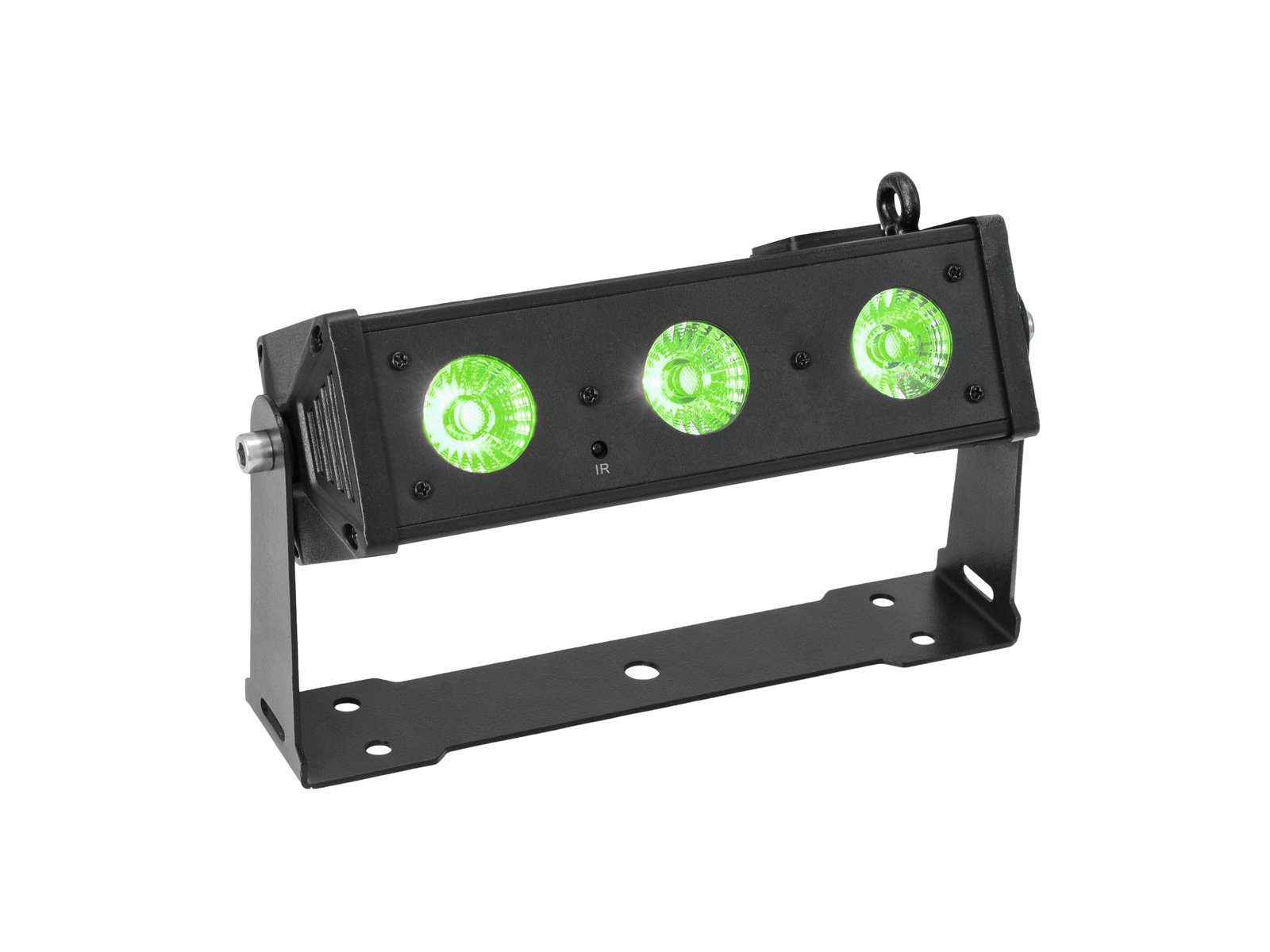
We’ll start with the Washes, The first Fixture we’re going to have a look at is the Eurolite LED BAR-3 HCL Bar. This fixture has 3 powerful 12W mixed Red, Green, Blue, Amber, White and UV (RGBWAUV) LEDs on the front of the fixture, which unfortunately can’t be controlled individually. It has several DMX control modes but I would suggest putting them in Mode 10 so you get the full functionality of the device with individual control of each of the colours, access to control of the strobe feature as well as a global dimmer. You also benefit from being able to use the built-in effects. you can pick them up for £77 each on Thomann’s Website.

If you have more room in your budget then it’s worth having a look at the Eurolite Stage Panel 16 HCL LED. It’s over 3 1/2 times the cost of the LED BAR-3, coming in at £279, but for that extra cost, you now get 16 12W RGBWAUV LEDs on the front grouped into 4 segments that are each individually controllable, even just one of these segments is more powerful than the 3 individual LEDS on the other wash unit. It also comes with built-in barn doors enabling you to stop the light from spilling into areas of the stage you don’t want to cover. The fixture can be controlled by either of the 2, 3, 5, 6, 8, 11, 24 or 32 DMX control Modes. Again I’d go with mode 32 here, then you will get control of the master dimmer, Strobe, and Each of the 4 segments, as well as some preset colours and effects.
Spots
When it comes to spots I’ve gone with three different options. One has what Thoman calls an LED Lens, the next has an adjustable Fresnel Lens and the final one is a full-zoom lens.

The first option I have is the Eurolite LED Theatre COB 100 RGB+WW which comes in at a somewhat budget-friendly £129 per fixture. It’s an RGBW fixture with a fixed 60-degree LED Lens on the front. It comes with 4, 5, 6 & 9 Channel DMX modes. Here I’d go with mode 6. This gives us control over each of the colours the master dimmer and the strobe. This fixture does include bar doors so you have some control of the area the light is covering but not how sharp the focus may be. A good very basic option to point some light in a direction and add some extra light.
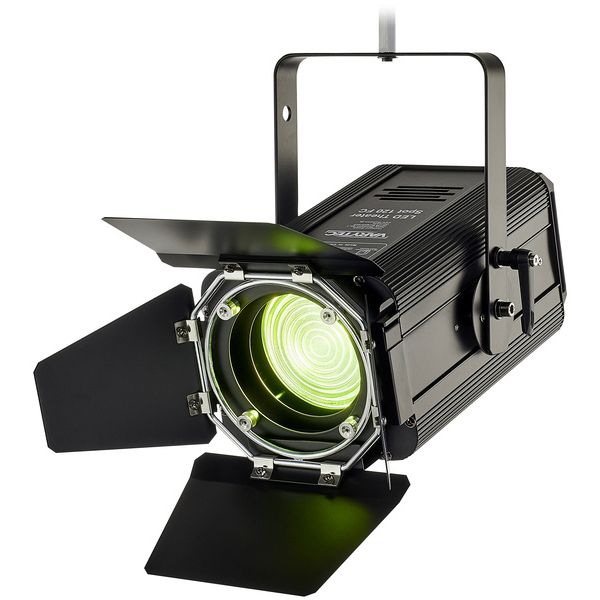
The second option I have come up with is just under three times the price of the COB 100 and that’s the Varytec LED Theater Spot 120 FC comes in at £333 a fixture. This fixture has a manually adjustable Fresnel lens that can be adjusted from 15-45 degrees. Like the COB 100, this fixture has RBGWW colour mixing. It also has 4,6 or 8-channel DMX control modes, I’d go with the 6-channel here as again you get the master dimmer as well as control off all four colours and the strobe. This fixture has been designed to replace the 500-600w Fresnel fixture you’ll find in smaller theatres and studio spaces.
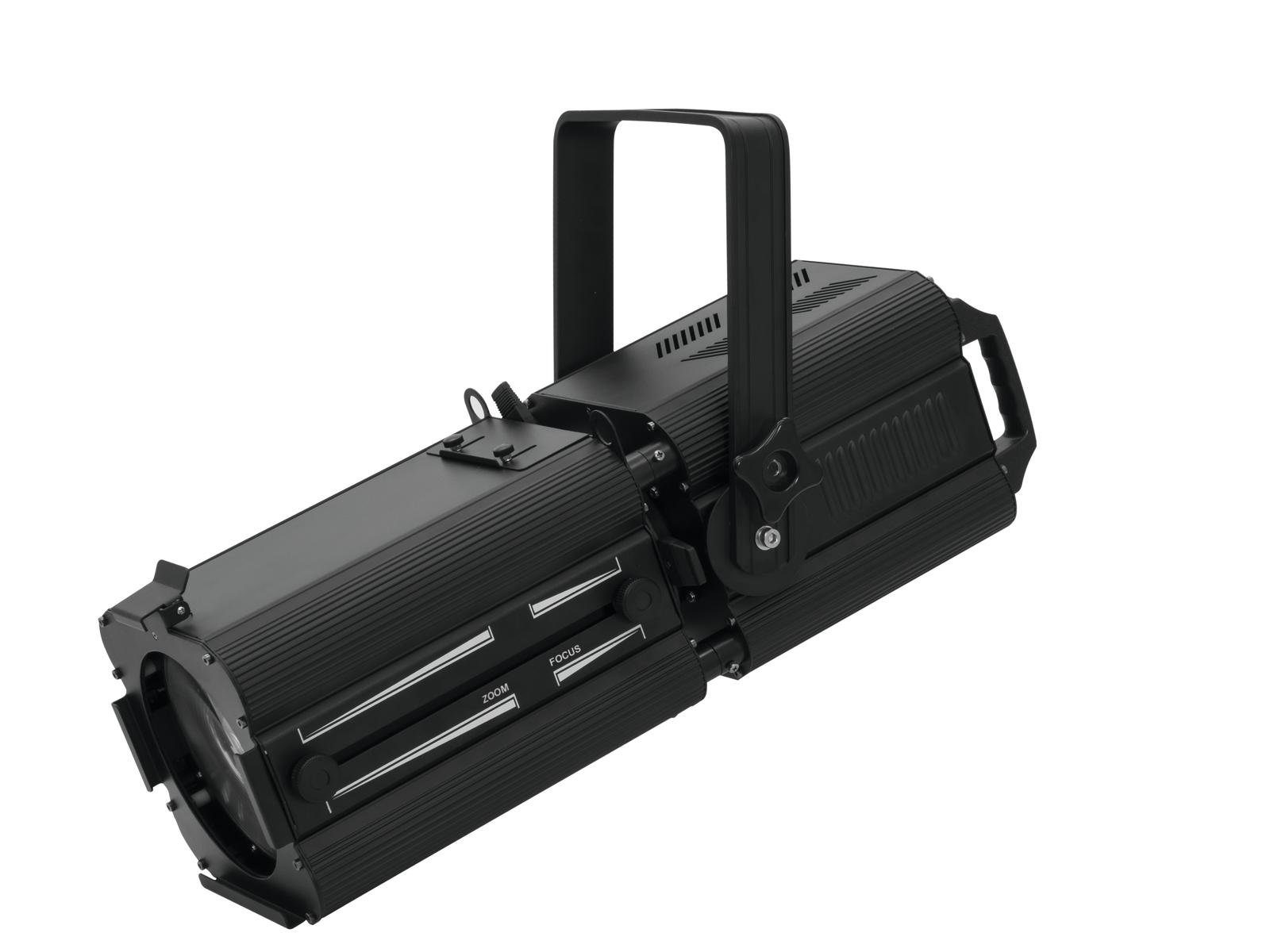
My Last option is the Eurolite LED PFE-100 RGBW Profile Spot which comes in at £555 on the Thomann website. It’s a full-on Profile Spot with full RGBW colour mixing and built-in shutter blades. The Fixture can accept a gobo holder and iris (both sold separately), a manual focus and zoom covering a range of 14-41 Degrees and is also controllable by the 9 channels of DMX (4 channels for RGBW, Macros – for colour blend, Colour Change and Colour Fade, Strobe, Dimmer Spead and Master Dimmer). Again the 110W nature of this fixture shows that it has been designed to replace Profiles that are in the 500-500W range at one-fifth the power. When I first saw it and read the spec I was instantly reminded of the source 4 Jr… well except for the shape that took me back to some of the fixtures from the early 90’s a good thing I love that aesthetic.
Power
Now you’ll need to be able to power all of these fixtures and managing our power is going to be important if we want to keep the venue managers off our backs. Doing some quick maths, and using the Phms Law Calculation (Power (P) = Current (I) x Voltage (V), each 13 amp socket you plug into here in the UK (running 230V) gives you 2990W of power, kind of. All the sockets on one ring main will, usually, run to a 32 amp breaker. Using the same calculation we need to make sure that we put no more than 7360W of equipment onto any ring taking into account any other devices that the venue may have plugged in.
With that in mind, we best have a look and see how much power each of the above fixtures uses. For some of the fixtures, this is going to be as simple as looking at the website or spec sheet and the figure will be there for the others we are going to have to do some more maths. Again the maths is simple though, Power of each LED x Number of LEDs + a little bit extra for the LED Controller and other gubbins in the fixture. This will give us a very rough approximation of the fixture’s energy use. It’s time for a table.
| Fixture | Power Use (If Known) | Number of LEDS | Power Per LED | Extra power budget | Total |
|---|---|---|---|---|---|
| Eurolite LED BAR-3 HCL Bar | N/A | 3 | 12W | 14W | 50W |
| Eurolite Stage Panel 16 HCL LED | N/A | 16 | 12W | 18W | 210W |
| Eurolite LED Theatre COB 100 RGB+WW | 100W | N/A | N/A | N/A | 100W |
| Varytec LED Theater Spot 120 FC | 120W | N/A | N/A | N/A | 120W |
| Eurolite LED PFE-100 RGBW Profile Spot | 100W | N/A | N/A | N/A | 100W |
With the figure above now worked out we can have a look and see what part of our setups use, power-wise. First of all, let’s have a look at one of the T-Bars in our 2 T-Bar setup. Let’s say we have 4 of the LED BAR-3 Fixtures and 2 of the Theatr Cob 100s, that would give us a total power usage of 400W per T-Bar so 800W for the full setup. Looking at the other end of the scale with our T-Bar and Truss rig, We have 8 Stage Panel washes on each T-Bar so that’s 1680W plus the 8 PFE 100 Spots using 800W gives us a total of 3280W.
Now T-Bar setup can easily run off a single 13 Amp plug socket and we’d need a second socket for one of the T-Bars in the larger setup, but for my own peace of mind, I’d be running each part of the rig to a separate socket. When it comes to distributing power though we’re, going to need some cabling.
For connecting between each fixture, Thomann supplies these handy the sssnake PC 1,5 Power Twist/DMX Cables that include both power and DMX cables for £24.90. As all of our fixtures have both power in and out as well as DMX in and out these are ideal to keep the rig nice and tidy.
When it comes to getting power and DMX to each part of the rig there is a 25M variant Sommer Cable Monolith1 Power Twist/DMX 25m for £196. 25M should be long enough to get back to our lighting console in most small-sized venues. All we’d need to do is cut off the grey power-twist connector and replace it with a 13 Amp Plug.
We’re going to need to be able to split the feed from or Light Console and send it to each part of the rig. Thankfully there are DMX Splitters for this purpose. The Eurolite DMX Split 4 Mini Splitter 3pol is a good option for this at £89. You can put this next to the Lighting Console, pop power into it and pass that through to the console, pop the DMX out of the console with a short 1M DMX Cable, such as this pro snake TPD-3 2 FM for £5, and the plug run a length of DMX from the splitter to each of our Power Twist/DMX Cables using a small single DMX Cable like this pro snake TPA 1003 FM5 for £3.44 that will convert the 5pin DMX out of our lighting console to the 3pin DMX Required for our splitter and fixtures.
The final thing I would add is to make sure that you include a DMX Terminal Resistor at the end of each DMX run to stop any dodgy signal from messing up your show. you can pick up a pack of 2 ADJ DMX terminal resistor Set 3Pin for £3.88.
Lighting Console
When it comes to the lighting console there are plenty of options but what we need to figure out is how many channels of DMX we need as that will set the minimum number of DMX universes we are going to need in our lighting console. So it’s time for another table.
| Fixture | DMX Channels | Qty | Total DMX Channels |
|---|---|---|---|
| Eurolite LED BAR-3 HCL Bar T-BAR | 10 | 8 | 80 |
| Eurolite Stage Panel 16 HCL LED Truss | 32 | 8 | 256 |
| Eurolite LED Theatre COB 100 RGB+WW T-BAR | 6 | 4 | 24 |
| Varytec LED Theater Spot 120 FC T-BAR | 6 | 8 | 48 |
| Eurolite LED PFE-100 RGBW Profile Spot Truss | 9 | 8 | 72 |
| Total | T Bar – 104/128 T-Bar & Truss – 328 |
The Number of Channels you’ll need will vary a bit depending on the setup you go for but if you go with any of the setup options I have laid out today you won’t need more than 1 universe of DMX. This keeps our options wide open for our choice of Lighting Console.
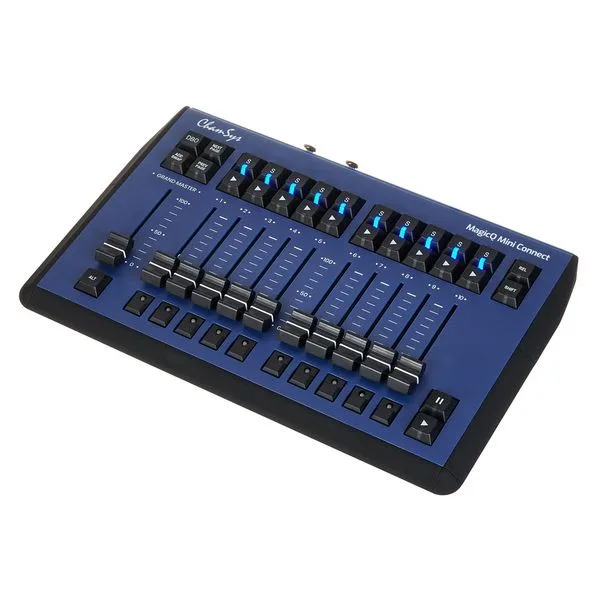
I’ve narrowed the field myself with my personal preference for Chamsys Lighting Console. I think they are great budget-friendly easy-to-use options that do not leave anything on the table even when running on a small setup like this. They have Console options that range from just running the console software on a laptop or computer using their FREE MagicQ Software and a USB-DMX Dongle, right the way through to their latest and greatest MQ500M+ Stadium console.
We’re going to go towards the bottom of the list of options that Chamsys provide by using the free MagicQ Software paired with either their ChamSys MagicQ Mini Connect that comes in at £1015 or if you have room in the budget I’d recommend going for the ChamSys MagicQ Compact Connect for £2269. The Copact Connect may be over twice the price but the physical interface you use is a lot better suited for live shows with its extra encoders and buttons to help you produce a show on the fly.
The Cost
I’m going to do three different cost listings here for the different setups that I think make sense. The first is a 2 T-bar setup with 6 Washes and 4 COB Spots.
| Product | Cost | Qty | Total |
|---|---|---|---|
| Varytec Wind Up 85 kg TÜV | £189 | 2 | £378 |
| Eurolite LED BAR-3 HCL Bar | £77 | 4 | £308 |
| Eurolite LED Theatre COB 100 RGB+WW | £129 | 4 | £516 |
| the sssnake PC 1,5 Power Twist/DMX Cables | £24.90 | 6 | £149 |
| Sommer Cable Monolith1 Power Twist/DMX 25m | £196.25 | 2 | £393 |
| Eurolite DMX Split 4 Mini Splitter 3pol | £89 | 1 | £89 |
| ChamSys MagicQ Mini Connect | £1,015 | 1 | £1,015 |
| ADJ DMX terminal resistor Set 3Pin | £3.88 | 1 | £4 |
| Total | £2,852 |
I think this isn’t a bad starting point for a good quality rig that can be used not just for bands but also for smaller events, for example, whilst I was studying at university a rig like this would have come in handy not only for the interviews that I filmed but also when I was helping provide tech support with the drama students. you can get a very good full-stage wash and 2 specials all with colour mixing for just under £3000 that can all be plugged into 1 13 amp socket, though I’d still recommend separate circuits if at all possible.
Next, I wanted to create a slightly more advanced 2 T-Bar rig based on everything we have discussed here and there are three main differences first is that I’m Swapping out the washes for the larger Stage Panel. Second, Swapping out the Theatre COB Spots for the Theatre Spot 120s and finally, I’m changing over to the MagicQ Compact Connect.
| Product | Cost | Qty | Total |
|---|---|---|---|
| Varytec Wind Up 85 kg TÜV | £189 | 2 | £378 |
| Eurolite Stage Panel 16 HCL LED | £279 | 6 | £1,674 |
| Varytec LED Theater Spot 120 FC | £333 | 2 | £666 |
| the sssnake PC 1,5 Power Twist/DMX Cables | £24.90 | 6 | £149 |
| Sommer Cable Monolith1 Power Twist/DMX 25m | £196.25 | 2 | £393 |
| Eurolite DMX Split 4 Mini Splitter 3pol | £89 | 1 | £89 |
| ChamSys MagicQ Compact Connect | £2,269 | 1 | £2,269 |
| ADJ DMX terminal resistor Set 3Pin | £3.88 | 1 | £4 |
| Total | £5,622 |
A fair jump in cost but with the jump in cost you also get a jump in power output and control. As I mentioned before having the MagicQ Compact Connect rather than the Mini Connect is going to give more options when it comes to busking a show. You don’t need to make this change if you are preprogramming your shows into a cue list or working with set scenes and chases that won’t change from gig to gig.
The final setup I’m going to look at today is the Full T-Bar and Truss setup. This is the kind of like the money is no object small band setup That
| Product | Cost | Qty | Total |
|---|---|---|---|
| Varytec Wind Up 85 kg TÜV | £189 | 2 | £378 |
| Stageworx LB-3 Lighting Stand Set 3m Bk | £155 | 1 | £155 |
| Eurolite Stage Panel 16 HCL LED | £279 | 8 | £2,232 |
| Varytec LED Theater Spot 120 FC | £333.00 | 8 | £2,664 |
| the sssnake PC 1,5 Power Twist/DMX Cables | £24.90 | 12 | £299 |
| Sommer Cable Monolith1 Power Twist/DMX 25m | £196 | 4 | £785 |
| Eurolite DMX Split 4 Mini Splitter 3pol | £89 | 1 | £89 |
| ChamSys MagicQ Compact Connect | £2,269.00 | 1 | £2,269 |
| ADJ DMX terminal resistor Set 3Pin | £3.88 | 2 | £8 |
| Total | £8,879 |
This setup has everything but the kitchen sink and is really more for band that are starting the progression from pubs and clubs into more dedicated venues but want to use their own lighting right. It’ll actually be the first setup of my next bunch of lighting setups in the next light part of the Event Rig Series.
One of my favourite things about this setup is its versatility. For example, because you have that front truss not only can you put all of your profile out front and your washes on the sides but you can do a bit of mix and match. For Example, Take 2 of the washes off each T-bar and put them on the Truss as the 2 outside lights on each side and have 4 profiles in the middle. Split the last four remaining Profiles and replace the 2 Washes on each bar with them. This can give you some additional side spot that can either be used to light a band member at an interesting angle or used with a gobo to add a bit of break up to the mix.
Summary and Final Thoughts
I’ve skipped atmospherics during these setups as a fair few of the pubs I’ve worked in over the years have flat-out refused to let us use Smoke and haze whilst putting on a gig, which was a pity as I think it could have added so much to some of those gigs. I’ll be covering a few of the options in the next lighting installment of the Event Rig Series so keep your eyes peeled if you want to add smoke and haze to your gigs.
I think we have three good starting blocks here depending on the size of your band and budget. If I can ever get a Windows machine to stay working on me for more than a couple of days then I’ll create some renders in WYSIWYG of what each of these setups could look like.
Not that anyone requested it but I’ve started adding all of my shopping lists to a single Excel spreadsheet that you can download from the link in the menu at the top of the page. If your interested in any of these rigs it may come in handy and you should just be able to edit the qty for each item and the totals will automatically update. It won’t automatically add cables and do power calculations for you though… maybe one day in the future if I have time to figure all of that out.
What do you think of the rigs? Would you change anything? let me know in the comments or on the socials and I’ll be happy to have a natter.

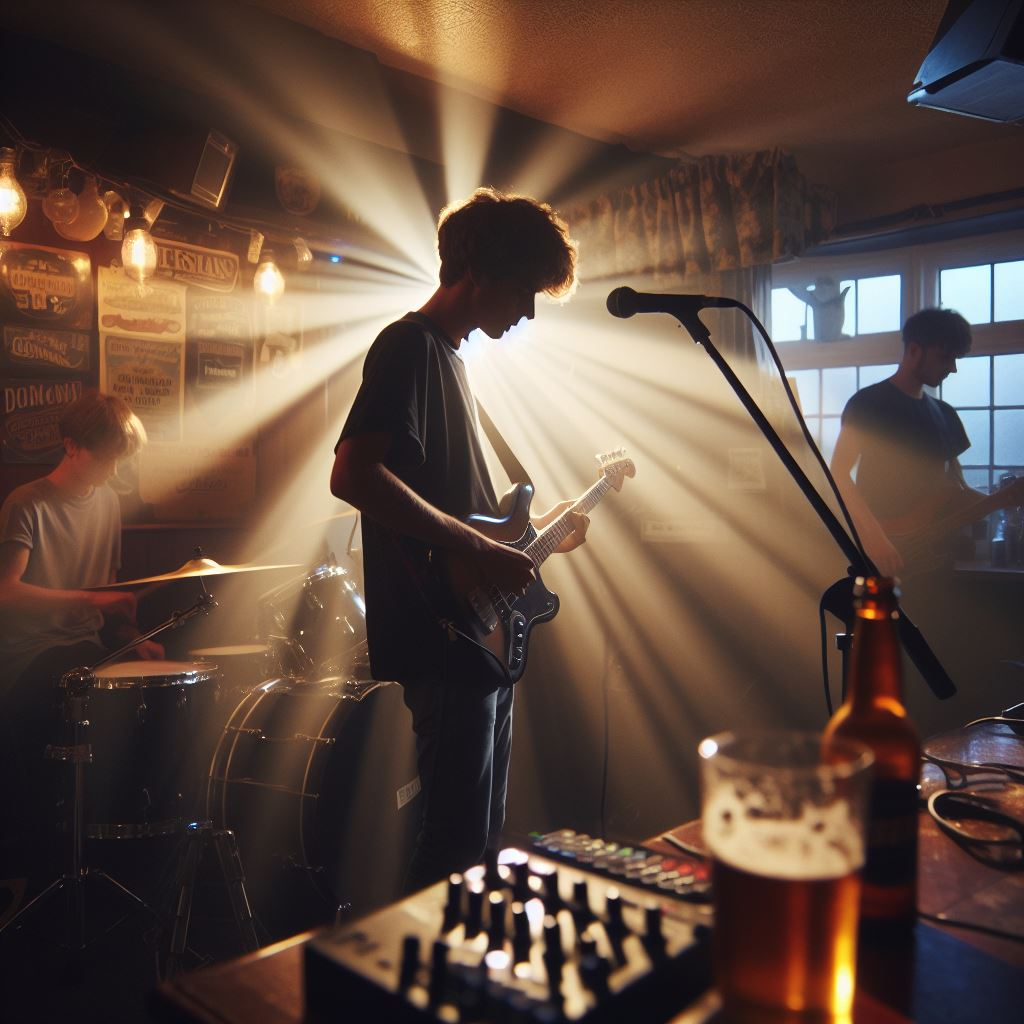
Leave a Reply